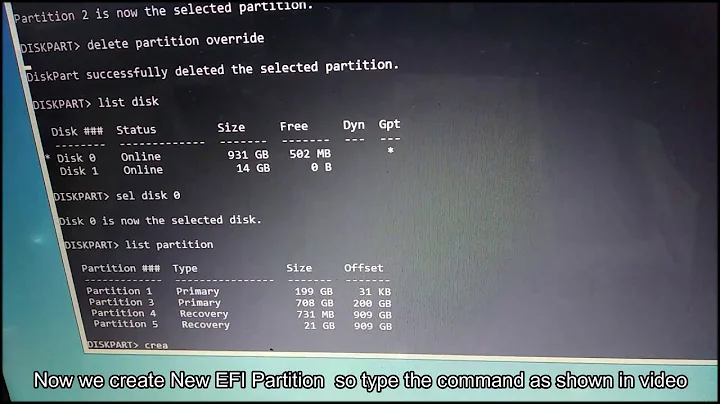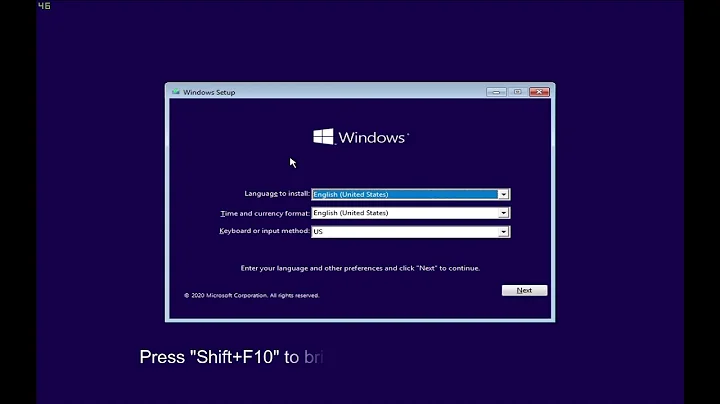Accidentally deleted efi partition
In my opinion the best course of action would be to:
- Take back up of all your data using Ubuntu.
- Delete all partitions on Disk 0 (the one with Windows installed).
- Install any of Ubuntu/Windows. They will create the required partitions themselves. (Preferably Windows
In case you want to try and salvage (that seems more difficult now) read on.
Try this first:
gdisk t 2 EFOO
gdisk t 4 0700
Then follow only the Steps 1, 2 and 3 below (DO NOT DO 4). Reboot to see if it works.
IF NOT, then proceed to the below instructions.
The 300MB SYSTEM partition is most likely (99.99%) the EFI partition. You don't need gparted for the operations we need.
Just boot into Ubuntu and run these:
-
Find you EFI partition's name
sudo fdisk -lThe EFI partition will be the one with size as 300MB as you have mentioned. Note it's name (/dev/sda2 most likely)
-
Mount the EFI partition
sudo mkdir /mnt/efipart sudo mount /dev/sda2 /mnt/efipart -
Copy the EFI directory to the partition from your windows install media. First find the name for your Windows install media using
fdiskas in step 1. Let us assume it is /dev/sdc1sudo cp -R /dev/sdc1/efi/* /mnt/efipart/EFI/ -
Set the EFI partition flags.
gdisk t 2 EFOO
BTW: Looking again at the partition table you just showed, it seems that this may not work (but is still worth a try).
In case this doesn't work, you will have to repartition the disk (start over from scratch) See these in case:
https://superuser.com/questions/764799/how-to-create-an-efi-system-partition
How do I create an EFI partition
Related videos on Youtube
Rutik Patil
Updated on September 18, 2022Comments
-
Rutik Patil over 1 year
Trying to install fastapi:
(venv) D:\api>pip install fastapi[all]Getting the following error:
ERROR: Command errored out with exit status 1: command: 'D:\api\venv\Scripts\python.exe' -u -c 'import io, os, sys, setuptools, tokenize; sys.argv[0] = '"'"'C:\\Users\\LENOVO\\AppData\\Local\\Temp\\pip-install-od3lrye2\\httptools_c5b546c7a9f54ea0831a3639b44e79da\\setup.py'"'"'; __file__='"'"'C:\\Users\\LENOVO\\AppData\\Local\\Temp\\pip-install-od3lrye2\\httptools_c5b546c7a9f54ea0831a3639b44e79da\\setup.py'"'"';f = getattr(tokenize, '"'"'open'"'"', open)(__file__) if os.path.exists(__file__) else io.StringIO('"'"'from setuptools import setup; setup()'"'"');code = f.read().replace('"'"'\r\n'"'"', '"'"'\n'"'"');f.close();exec(compile(code, __file__, '"'"'exec'"'"'))' install --record 'C:\Users\LENOVO\AppData\Local\Temp\pip-record-x1m88nnc\install-record.txt' --single-version-externally-managed --compile --install-headers 'D:\api\venv\include\site\python3.10\httptools' cwd: C:\Users\LENOVO\AppData\Local\Temp\pip-install-od3lrye2\httptools_c5b546c7a9f54ea0831a3639b44e79da\ Complete output (25 lines): running install running build running build_py creating build creating build\lib.win-amd64-3.10 creating build\lib.win-amd64-3.10\httptools copying httptools\_version.py -> build\lib.win-amd64-3.10\httptools copying httptools\__init__.py -> build\lib.win-amd64-3.10\httptools creating build\lib.win-amd64-3.10\httptools\parser copying httptools\parser\errors.py -> build\lib.win-amd64-3.10\httptools\parser copying httptools\parser\__init__.py -> build\lib.win-amd64-3.10\httptools\parser running egg_info writing httptools.egg-info\PKG-INFO writing dependency_links to httptools.egg-info\dependency_links.txt writing requirements to httptools.egg-info\requires.txt writing top-level names to httptools.egg-info\top_level.txt reading manifest file 'httptools.egg-info\SOURCES.txt' reading manifest template 'MANIFEST.in' adding license file 'LICENSE' writing manifest file 'httptools.egg-info\SOURCES.txt' copying httptools\parser\parser.c -> build\lib.win-amd64-3.10\httptools\parser copying httptools\parser\url_parser.c -> build\lib.win-amd64-3.10\httptools\parser running build_ext building 'httptools.parser.parser' extension error: Microsoft Visual C++ 14.0 or greater is required. Get it with "Microsoft C++ Build Tools": https://visualstudio.microsoft.com/visual-cpp-build-tools/ ---------------------------------------- ERROR: Command errored out with exit status 1: 'D:\api\venv\Scripts\python.exe' -u -c 'import io, os, sys, setuptools, tokenize; sys.argv[0] = '"'"'C:\\Users\\LENOVO\\AppData\\Local\\Temp\\pip-install-od3lrye2\\httptools_c5b546c7a9f54ea0831a3639b44e79da\\setup.py'"'"'; __file__='"'"'C:\\Users\\LENOVO\\AppData\\Local\\Temp\\pip-install-od3lrye2\\httptools_c5b546c7a9f54ea0831a3639b44e79da\\setup.py'"'"';f = getattr(tokenize, '"'"'open'"'"', open)(__file__) if os.path.exists(__file__) else io.StringIO('"'"'from setuptools import setup; setup()'"'"');code = f.read().replace('"'"'\r\n'"'"', '"'"'\n'"'"');f.close();exec(compile(code, __file__, '"'"'exec'"'"'))' install --record 'C:\Users\LENOVO\AppData\Local\Temp\pip-record-x1m88nnc\install-record.txt' --single-version-externally-managed --compile --install-headers 'D:\api\venv\include\site\python3.10\httptools' Check the logs for full command output.-
Ashhar Hasan over 8 yearsTry using a Windows installation disk, it will be able to make the required partitions. You may try to manually remake the EFI partition if you are willing. Not a difficult task. I'll add instructions as an answer if you say so. And before using the Windows disk, make sure to turn on SecureBoot otherwise Windows will say something about GPT disks. (That Legacy is why Windows was complaining)
-
Ashhar Hasan over 8 yearsLook in the documentation for your system's motherboard. They usually have a key to directly go to boot menu (bypassing the BIOS). F12 on new Dells and F2 on recent ThinkPads. I'll add the instructions soon.
-
Mike Menart over 8 yearsI got back into the bios and disabled secure boot. For some reason in legacy mode I had to use a different key at boot. I went to my windows 10 usb installer, and now it seems to at least recognize my D drive as a valid install target (for some reason it still doesn't let me use my C drive, maybe because its raid?). However, it wouldn't let me install windows 10 on it because it was ntfs configured instead of fat32, so I guess I'm going to try messing with that a bit. I'd still much rather prefer to install the os on the C drive though, as its msata instead of solid state.
-
Mike Menart over 8 yearsCorrection, its the efi partition of the d drive that needs to be formatted as fat32. How do I do that? Better yet, how do I put an actual efi partition on my C drive as that would be much better in the end.
-
Ashhar Hasan over 8 yearsWhen you will tell Windows to proceed with the installation it will tell you that it needs to create certain extra partitions to function properly. Try deleting a partition (preferably the small first partition on your disk). But it would be much better if i could see a photo maybe of what you are seeing.
-
Ashhar Hasan over 8 yearsLooking at the gdisk output, the easiest way for you is to delete all partitions on /dev/sda. Start the Windows setup (with secure boot enabled) and create a partition through the Windows setup. It will then set up all required partitions. Btw, if you are using the Windows setup from a live USB, make sure it is GPT compatible otherwise it may give you the same error about GPT disks.
-
Mike Menart over 8 years@Hasan, Looking back at the gdisk output, it doesn't seem to even acknowledge my C drive partitions, just the partitions on my d drive. I'm a little bit worried about reconfiguring the entire partition table due to the fact that my entire C: drive partition is msata RAID0, which makes it rather complicated and I'm not sure I'd be able to reconfigure it. As far as GPT compatible, how would I make sure the setup is GPT compatible? Is there something I can do to make it GPT compatible? Also, I'll try to get a picture posted soon with the error I'm seeing.
-
Ashhar Hasan over 8 yearsTo ensure that the Windows installation media is GPT compatible, try seeing if the installation media has an
efisubdirectory and that secure boot is on. The above two together mean you are running GPT compatible. -
Ashhar Hasan over 8 yearsAs a shot in the dark solution, try copying the efi folder onto the EFI partition using Ubuntu.
-
Mike Menart over 8 yearsThe installation media has an efi subdirectory, and I'm running in secure boot so that should be taken care of. I don't know how I would copy the file to the efi partition, as I can't find the efi partition (if there actually is one), because it doesn't show up in the windows install partition list and gparted won't work... Also I added some pictures above.
-
Ashhar Hasan over 8 yearsSee the answer below.
-
Ashhar Hasan over 8 yearsPossible duplicate of Can't boot after deleting EFI boot- and Windows-partition
-
ozacha over 2 yearsDo you have Microsoft Visual C++ installed?
-
-
Mike Menart over 8 yearsYou basically got it. In the end the right thing to do was just recreate the entire partition table, make an efi partition, and install windows 10 from there. For some reason this took a few tries... but it worked eventually.
-
Ashhar Hasan over 8 yearsI am glad your problems were resolved. But still I was hoping to be able to save you the effort of configuring stuff again.
-
Rutik Patil over 2 yearsthank you It worked
-
Tal Folkman over 2 yearscan you vote and accept my answer? @RutikPatil





